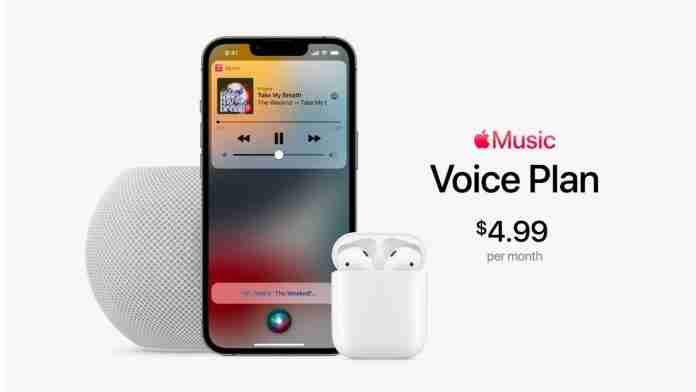Apple Music is one of the most popular audio streaming services on the planet, and it’s just getting better. Apple Music isn’t just for Apple devices; you can use it on Android smartphones, desktops, Amazon or Google smart speakers, and any Web browser. Furthermore, the advent of high-resolution audio streaming without a rise in costs has made this one of India’s most well-equipped and cost-effective music streaming services, especially if you have at least one Apple device to utilize it with.
Apple is now supporting the Apple Music Voice Plan, which is now the cheapest tier accessible on the service, with the new iOS 15.2 update. The Apple Music Voice Plan, which costs Rs. 49 per month in India, gives you access to the streaming service’s entire catalog of over 90 million songs on supported devices, but there’s one catch: you have to use Siri to request tracks or playlists. I got an opportunity to try out the new Apple Music Voice Plan, and here’s how it works.
Price and free trial information on Apple Music Voice Plan
The Apple Music Voice Plan, which was announced globally in October 2021, costs Rs. 49 per month in India. Individual tracks and tailored playlists are available with this package. You get ad-free streaming and the ability to skip music, among other things.
You may even experience the service for free before you subscribe; there is a seven-day free trial that you can activate with just a voice command, without having to enter any payment information. You can also sign up for a three-month free trial, after which you will be billed using any payment method associated with your Apple account. The most important thing to remember is that with the Voice Plan, the only method to access most material is to use voice commands to Siri on a compatible device.
Compatible devices for Apple Music Voice Plan
The Apple Music Speech Plan uses Siri, Apple’s voice assistant on smartphones and other devices, to process voice commands. You must be running iOS 15.2, iPadOS 15.2, watchOS 8.3, tvOS 15.2, macOS 12.1, or software version 15.2 for the HomePod and HomePod mini smart speakers to subscribe to the Voice Plan or even use the free trial.
Naturally, you’ll also need a smartphone with the Siri speech assistant built-in, as well as Internet access. On a variety of devices, including an Apple HomePod mini, an Apple iPhone 13, and a CarPlay-compatible system with the same iPhone attached, I explored utilizing voice commands to fetch tracks and playlists. Apple Watch, AirPods earphones and headphones, Mac desktops, and Apple TV streaming devices are all compatible.
How does the Apple Music Voice Plan work?
With a simple voice command, I initiated the 7-day trial of the Apple Music Voice Plan on the HomePod mini: “Hey Siri, start my Apple Music Voice trial.” I was successfully subscribed to the free trial on both the smart speaker and the iPhone, which was linked to the same Apple account as the HomePod mini, and I was able to play tracks and playlists on both the smart speaker and the smartphone.
The ‘Listen Now’ option in the Apple Music app on any device will provide rudimentary recommendations and limited listening history for Voice Plan members. Some of these tunes and playlists can be listened to without using voice commands, however, this is a small selection. This is the only portion of the experience that doesn’t rely on speech, and the app doesn’t allow you to search for certain tunes.
The Search page displays a plethora of suggestions and recommendations, nicely organized by genre, mood, and other factors. However, I could only play these songs or playlists by telling Siri to do so. The library is huge, but the experience is mainly dependent on how you direct Apple’s voice assistant.
With a voice command, I was able to get almost any track or tailored playlist. Playing a tune is simple and works nicely on the HomePod mini and iPhone 13 mini in my experience. With simple voice instructions, I was able to play most tunes, and Siri is well-suited to the Indian accent and usage preferences. When I requested a single piece of music, Apple Music automatically created a playlist of related recommendations to play when it ended.
I could also request different playlists based on genre, era, and artist. This included more difficult requests like ‘play upbeat 1980s music’ or ‘play Hindi music featuring Shah Rukh Khan,’ with Siri generally producing a decent playlist in response.
Siri can accept requests in various regional languages when the language is set to English (India), although it functions best when spoken in English. It’s worth noting that Apple Music services like track downloads, lossless audio streaming, and Dolby Atmos Spatial Audio are currently unavailable on the Voice Plan. You can’t make custom playlists or add songs to your library unless you bought them from iTunes.
Siri and Apple Music are well-suited to working with voice commands on supported devices, which is critical to the Voice Plan’s success. However, being able to retrieve tracks solely through voice requests has some drawbacks. I was frequently unable to play certain remixes or versions of a track, or a remix or cover version was played when the original was desired.
The longer the track or artist’s name, the longer the command, and this frequently resulted in Siri making mistakes and playing the erroneous track. Manually searching for a track by text would easily fix this, but it isn’t an option here.
Finally, some thoughts
Apple Music is now the greatest streaming service in India, thanks to its widespread availability, access to high-resolution and Dolby Atmos recordings, and a vast catalog of genres and artists. It’s even greater value if you’re in India, with pricing that is significantly lower than the equivalents in most worldwide markets. An Apple Music membership is a no-brainer if you currently own Apple gadgets like an iPhone or a HomePod mini.
Despite its limits in terms of how you may access music, the Voice Plan is an excellent complement to the existing alternatives, providing customers with a cost-effective method to get started with premium music streaming. It may make sense for consumers of less priced iPhone or iPad models, but the individual plan, at Rs. 99 per month (or Rs. 999 per year), is not much more expensive and provides significantly more capabilities.
Furthermore, particularly in India, an Apple One or Apple Music Family Plan provides superior value for money. You’ll get all of the same benefits as the more expensive Individual Plan if you qualify for the Student Plan, which is also priced at Rs. 49 per month.
The Apple Music Voice Plan, on the other hand, maybe especially handy if you have a HomePod mini or AirPods earbuds, which are designed to operate flawlessly with Siri. It could be a good place to start before moving on to the Rs. 99 per month Individual Plan or the Rs. 149 per month Family Plan. If you listen to the majority of your music on a smart speaker like the HomePod mini, it could be useful in the long run.














![Technical Aspects of 844 Area Code in 2024 [Detail Guide] 844 Area Code](https://articleify.com/wp-content/uploads/2024/01/844-Area-Code-150x150.jpg)














